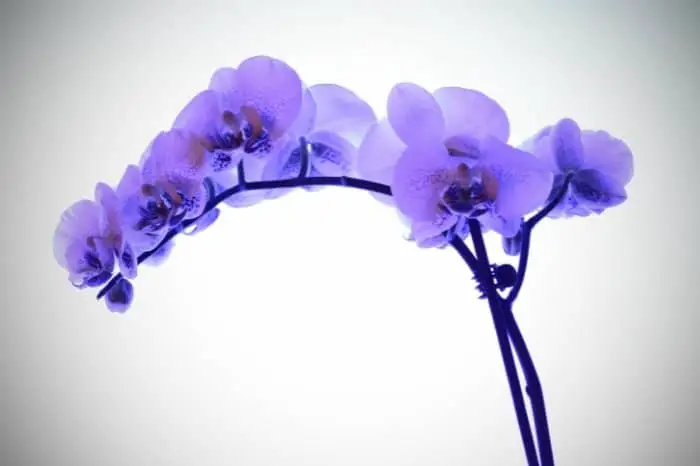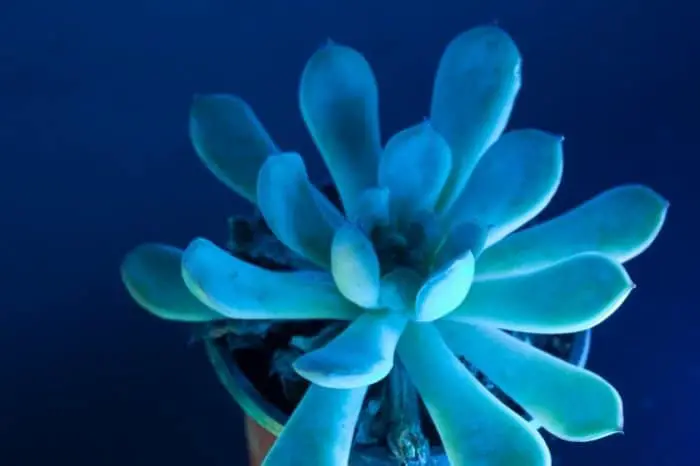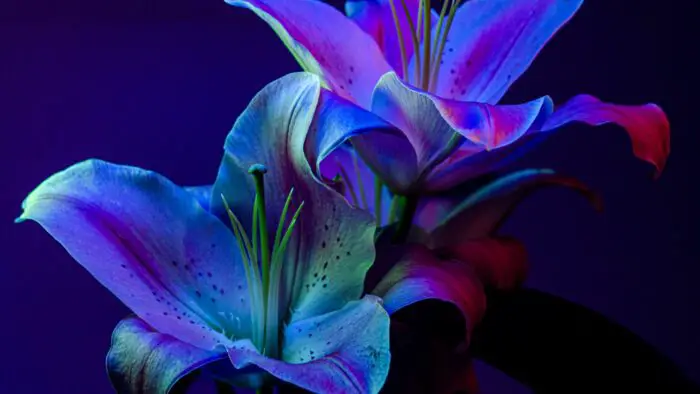Last Updated on February 22, 2023
Wondering if black light for plants works? Plants require light to grow, be it artificial light or natural sunlight. Now, this light comes in various colors of the spectrum. Different light colors are required by your plants at their various stages of growth.
Ultraviolet (UV) light is also emitted in the light spectrum and some forms of it are absorbed by ozone, water vapor, oxygen, and carbon dioxide in the atmosphere. It is the black light that emits UV radiation and we will be talking about its effect on plants’ growth.
Ultraviolet Black Light for Plants Growth
As we said, a black light emits UV light. The types of UV light produced by black lights are UVA and UVB. Various light wavelengths are absorbed by chlorophyll and phytopigments known as photosynthetic pigments. The lights are assimilated and help to carry out the process of photosynthesis.
Among all the colors of light, chlorophyll vigorously assimilates the blue region more. However, chlorophyll also has strong assimilation for some ultraviolet spectrum portions. The longest wavelength which is found in UVA is firmly assimilated by plants.

Effect of Black Light (UV Light) on Plant Growth
The effect of UV light varies with different plants. You need to be cautious if you wish to use black lights to help support your plants’ growth. This is because too much UV radiation can cause great harm to phytopigments.
Growing plants under black lights alone in the absence of white light may be damaging. You will be depriving them of benefiting from other colors of light. Your plants may grow with a blacklight but they will start to grow leggy because they are missing other colors.
Also, your plants’ chances of blooming with black lights are very slim. However, in a safe dose, your plants may benefit from ultraviolet black light.
-
Effect of UV light on microorganisms
Microorganisms in plants offer both good and bad effects. There are some microorganisms such as bacteria that affect plants negatively by causing rust and wilting, which give rise to diseases. Ultraviolet light can help kill these harmful bacteria, as well as other pathogens.
Grow Light for Indoor Plants – Upgraded Version 80 LED Lamps with Full Spectrum & Red Blue Spectrum
However, we also have some beneficial bacteria such as the nitrogen-fixing bacteria present in plants. They help fix the nitrogen used by plants. Ultraviolet light always ends up destroying beneficial microbes which play a vital part in the development of your plants. Thus UV is not ideal for the use of killing microbes.
-
Effect of UV light on plant DNA
Generally, it is well known that UV rays are pretty damaging to any life form. Now, UV rays are damaging to proteins, DNA, and lipids. So, if the DNA of a cell gets impaired, the genetic substance depreciates and this may bring about mutations or programmed cell death.
Although the damage done to the DNA may usually not be adverse, it may end up causing mutation in plants. Now, a mutation in plants may give rise to significant diversity which can result in better adaptable plants or even organisms.
But generally, plants don’t really need UV light because it actually brings more harm than good. But in a situation where plants end up getting UV light, it forces a reaction that protects plants and ends up boosting certain properties in them.
-
UV resistant crops
The earth continues to experience some climatic crises. This has been causing the ozone layer that protects the earth from the sun’s UV rays to deplete. Our worry is how damaging can this be to both humans and plants.
The good news is that researchers have been working on the effect of UV on crops and how they can be protected. Researchers have conducted laboratory experiments showing that plants are adapting. It shows that outdoor plants exposed to more UV rays have begun generating molecules to obstruct UV lights.
Therefore, plants can now thrive in severe climatic conditions. At the same time, plants can use UV light to their advantage to fight diseases bothering the plant.
However, UV light is generally detrimental to plants and the negative effect of UV black lights outweighs their advantages.
Are Black Lights and Grow Lights The Same?
Grow lights typically contain a good mix of light in different wavelengths that plants need for growth. This is including the black light that emits UV. Some grow lights naturally emit UV through chemical exchange. Grow lights such as HIDs and T5 grow lights. LED grow lights,s on the other hand can be built with specialized UV-B bulbs or diodes to give them the UV (to give off UV-B) they do not naturally come with.
Ultraviolet light is inane wavelengths of between 320 and 400 nanometers. Unlike lights in other wavelengths that are visible to the human eye, many birds and a small number of humans can perceive light in this wavelength.
Do Plants Need UV Light?
There are different perceptions and opinions about the usefulness of UV light for plants.
Plants that are grown with the use of black lights alone usually will suffer from numerous consequences because of being deprived of natural light.
Excessive UV radiation can have negative effects on plant phytopigments. Some studies have found that removing UV light from white light sources would improve plant growth.
Blacklightt emits UV radiation in the UVA and UVB regions. Chlorophyll from plants strongly absorbs long wavelengths in the UVA region. From this perspective, it is safe to assume that black light would not be ideal for any plant. Plants grown under black light tend to grow poorly or fail to grow at all.
There are however certain benefits that have been observed with the use of UV light for plants. Moderate UVC can kill certain plant pathogens. An excess,s however, can kill beneficial microbes that play a positive role in the growth of plants and other important organisms. Some plants have been specifically found to benefit from the use of UV light. One of these plants is Marijuana. In marijuana, UV light increases the production of CBD and THC, as a coping mechanism to protect the plant from harmful UV radiation. CBD and THC are the active ingredients of the plant. Because of this, LED grow lights used by marijuana growers have UV added to them.
Are Black Lights Bad for You?
As we have discusses, there are different types of black lights or UV lights. There is UVA, UV, B, and UVC. Of these three types, the short wavelength UVC is the most damaging to humans. Fortunately, it is filtered by the atmosphere before it reaches the earth’s surface. Medium wavelength UVB is biologically active, but cannot penetrate past the top layers of the skin.
Prolonged exposure to UV light emitted by black light can be harmful. It can potentially be damaging to your eyes and can affect your vision over time, as well as your skin.
For example, long periods spent in direct exposure to UVA light, such as in tanning beds have been found to cause skin damage.
If you have to work with UV lights in enclosed growing spaces, be sure to wear protective clothing or materials to reduce the risk of damage to your skin and eyes.
How Long to Leave UV Light on Plants
All plants differ in the amount of UV that they require, and can cope with. These differences are present even in plants of the same strain.
Because of these differences, the best way to start is to expose your plants to just 2 hours per day of UV light. It might be best to even split these into 2,1-hour stints. You can increase this time by 15 minutes every two days. If you notice that the top smaller leaves are burning a little, reduce the exposure time by about 30 minutes per stint.
Diligently following this procedure will allow you to get the best out of giving your plants UV light, without causing any damage to them.
The Best UV Light for Indoor Plants
If you grow plants indoors, you should be supplementing your plants with some UV light. UV light can help with plant growth in several ways. It can also help with the potency and overall quality of plant flowers.
However, there are only certain types of UV light that are beneficial to plants. Remember, UV is broken down into 3 categories, i.e. UVA, UVB, and UVC. Only UVA and UVB are essential for certain parts of life on earth, but UVC is not.
A bit more about UVA and UVB;
- Ultraviolet A (UVA)
UVA light is in wavelengths between 320 nm and 400 nm. It contains approximately 3% of the photons that are present in natural sunlight that comes through the earth’s atmosphere. This type of UV has no harmful effects on DNA.
- Ultraviolet B (UVB)
This type of UV is in wavelengths between 29 nm and 320 nm. It contains about 1/5 of 1% of natural sunlight. Unlike UVA, UVB can cause damage and can cause cancer in humans and animals.
When it comes to providing your plants with UV light, the best way to do it is to get a high-quality UV-to-grow light. Many full-spectrum LED lights emit just the right amount of UV. They also mimic natural sunlight, so they will be great and make your plants feel as if they are growing outside.
There are other lights that such as ceramic CMH grow lights which emit UV light, this is along with some double-ended bulbs.
With all these options, it can be confusing to know which light to choose. Here are four lights that we recommend for you;
- Black Dog LED
- California Lightworks SolarSystem UVB
- Sun System LEC Boss 315 Watt Grow Light
- HLG 30 Watt UVA Supplement LED Grow Light.
Another factor to consider when using a UV light for your plants is to use it in small doses over the entire life of the plant, instead of using it in high doses. This way, it will be safer and more effective.
Final Note – Black Light For Plants
As you have read from this article, there are specific uses, and ways to use UV light for plants so that it does not lead to damage. It can be beneficial in some cases and detrimental in others. Therefore, before you use any black light on your plants, determine whether or not your plants need it, and how best to expose your plants. If you use black light appropriately, such as in conjunction with other light colors, it has the potential to greatly benefit your plants.
FAQs
Does ultraviolet light help with Plant Growth?
The answer depends on what you are growing. The most common UV wavelengths used for indoor horticulture are 365nm, 390nm and 385nm. If you are growing plants that require a lot of light, such as tomatoes, peppers or cucumbers, then the plant will be able to grow normally with a certain amount of UV light.
However, if you are growing plants like broccoli, kale, Brussels sprouts, spinach, cabbage, carrots, parsley, basil, lettuce and other leafy greens, then you will need more than the standard UV dose that comes from the sun. If you are growing these plants, you can use an UV lamp, which is available at nurseries and hardware stores. The UV light for horticulture comes in three different wavelengths: 365nm, 390nm and 385nm. These three wavelengths are used for different types of plants. Some plants require UV light at all times while others require it only in the daytime. The most common wavelength used for indoor horticulture is 365nm. This is because the 365nm wavelength has been proven to be the most effective in providing the optimal amount of light for plants.
What's the relation between UV and plant growth?
Ultraviolet (UV) radiation is part of the electromagnetic spectrum, which includes visible light, radio waves and X-rays. It consists of wavelengths shorter than that of visible light, but longer than those of X-rays. Ultraviolet radiation comes from the Sun, and it can also be generated artificially by high-intensity light bulbs. Ultraviolet radiation is important for plant growth and development because it helps in regulating the balance between the processes of photosynthesis and photorespiration.
How sensitive are plants to black lights?
Ultraviolet (UV) radiation is a form of solar radiation that can cause sunburn, skin cancer and other serious health problems. UV-B radiation causes skin cancer and cataracts; UV-A radiation is responsible for tanning of the skin. Although most plants are sensitive to UV-B radiation, some species have evolved ways to protect themselves against it. The same protective mechanisms apply to UV-A radiation, but they are not as widespread in nature.
Sunlight is composed of visible light, ultraviolet (UV) light and infrared light. The spectrum of UV light is divided into three bands: UVA, UVB and UVC. The UVA band, with wavelengths between 320 and 400 nm, penetrates the atmosphere and reaches the earth's surface.
Does it affect the DNA od plants?
Not always, but it can cause mutations and damages. You should research which plants are resistant to UV rays and which ones are not.

Eunice is an enthusiastic gardener with a passion for growing beautiful flowers. She loves nothing more than spending time in her garden, tending to her plants and enjoying the outdoors. Eunice has been gardening for over 15 years and has developed a unique style of landscaping that is both practical and aesthetically pleasing. She is especially fond of growing roses and enjoys experimenting with different varieties and colors. Eunice takes great pride in her garden and often shares the fruits of her labor with friends and family. In her spare time, she enjoys reading gardening magazines and attending local horticulture events. Eunice is passionate about her hobby and is always eager to share her knowledge and experience with others.



